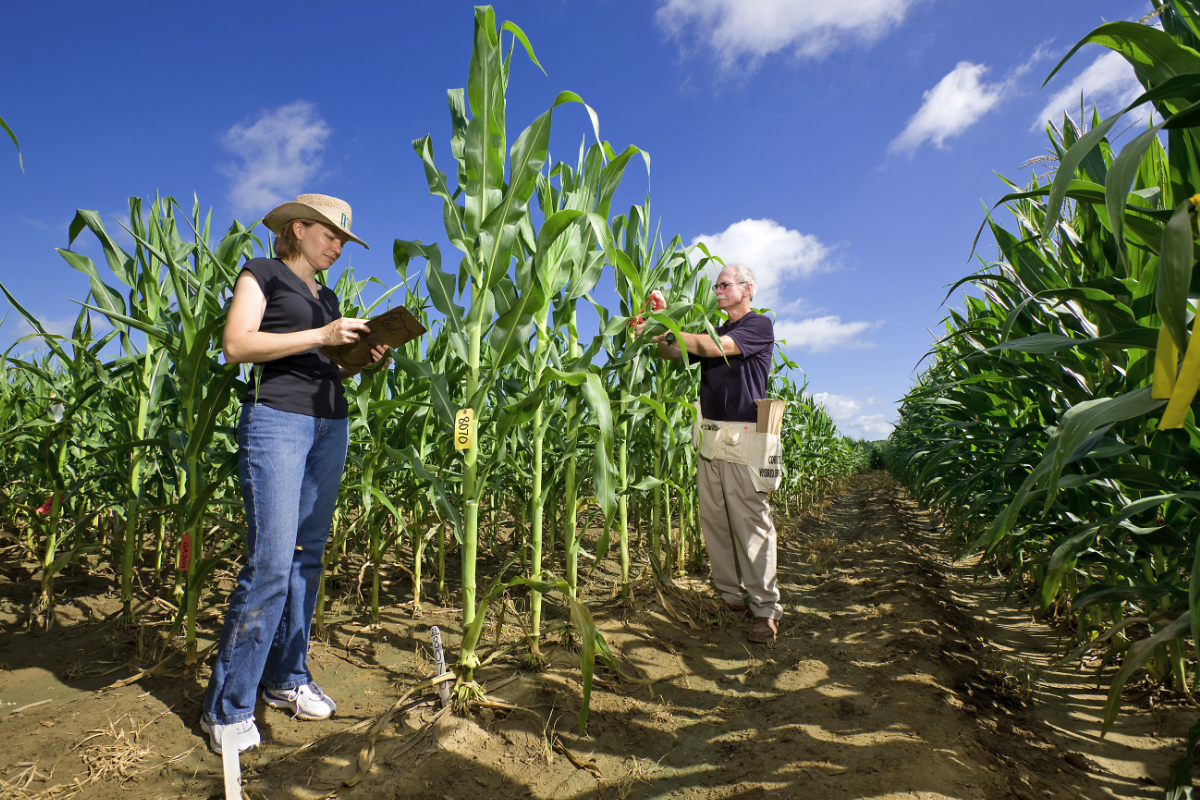New tool aims to identify important crop traits. A new computer application is working to speed the search for genes that underpin important crop traits, like high yield, seed quality and resistance to pests, disease or adverse environmental conditions.
Created by scientists at the US Department of Agriculture’s (USDA) Agricultural Research Service, the Pathway Association Studies Tool (PAST) app allows users to build on the results of genome-wide association studies (GWAS) of crops. GWAS takes a broad look at a crop plant's genome for marker regions called single nucleotide polymorphisms (SNPs).
Finding SNP markers near the gene or genes encoding a desired trait can flag the genomic whereabouts of those genes and help plant breeders follow the trait's inheritance and expression. This makes it easier to select plants that have the desired trait and develop new, better varieties from them for producers.
Marilyn Warburton, a geneticist with ARS's Corn Host Plant Resistance Research Unit (CHPRRU) at Mississippi State, Mississippi used both GWAS and PAST which has led to the identification of genes in corn plants for resistance to the corn earworm (a caterpillar pest) and Aspergillus flavus, a greenish mold that produces a carcinogen called aflatoxin. Unchecked, corn earworms feed on the corn plant's silks and kernels, causing damage that fosters Aspergillus growth and aflatoxin contamination.
According to the ARS, corn or other grains with aflatoxin levels exceeding 20 parts per billion cannot be sold for human consumption, and the grains' use for animal feed is restricted. In the United States, outbreaks of Aspergillus molds that produce the carcinogen inflict more than $200 million annually in economic losses for corn and $300 million for peanuts and other crops combined.
Warburton's research is part of a broader effort at CHPRRU together with Mississippi State University (MSU) collaborators to pre-empt aflatoxin on multiple fronts — with plantings of resistant corn varieties being a keystone defense.
Related:
30 March 2020. Exeter researchers discover a novel chemistry to protect our crops from fungal disease.
A consortium of researchers from the University of Exeter, led by Professor Gero Steinberg, combined their expertise to join the fight against plant pathogenic fungi.
In a recent publication, in the prestigious scientific journal Nature Communications, they report the identification of novel mono-alkyl chain lipophilic cations (MALCs) in protecting crops against Septoria tritici blotch in wheat and rice blast disease.
These diseases challenge temperate-grown wheat and rice, respectively, and so jeopardise the security of our two most important calorie crops. The scientists’ journey started with the discovery that MALCs inhibit the activity of fungal mitochondria. Mitochondria are the cellular “power-house”, required to provide the “fuel” for all essential processes in the pathogen. By inhibiting an essential pathway in mitochondria, MALCs cut down the cellular energy supply, which eventually kills the pathogen.
The paper, published in the Journal Nature Communications, is entitled: “A lipophilic cation protects crops against fungal pathogens by multiple modes of action”, authored by G. Steinberg, M. Schuster, S.J. Gurr, T. Schrader, M. Schrader, M. Wood, A. Early and S. Kilaru.
Once published, the paper will be available at http://dx.doi.org/10.1038/s41467-020-14949-y
Created by scientists at the US Department of Agriculture’s (USDA) Agricultural Research Service, the Pathway Association Studies Tool (PAST) app allows users to build on the results of genome-wide association studies (GWAS) of crops. GWAS takes a broad look at a crop plant's genome for marker regions called single nucleotide polymorphisms (SNPs).
Finding SNP markers near the gene or genes encoding a desired trait can flag the genomic whereabouts of those genes and help plant breeders follow the trait's inheritance and expression. This makes it easier to select plants that have the desired trait and develop new, better varieties from them for producers.
According to the ARS, corn or other grains with aflatoxin levels exceeding 20 parts per billion cannot be sold for human consumption, and the grains' use for animal feed is restricted. In the United States, outbreaks of Aspergillus molds that produce the carcinogen inflict more than $200 million annually in economic losses for corn and $300 million for peanuts and other crops combined.
Warburton's research is part of a broader effort at CHPRRU together with Mississippi State University (MSU) collaborators to pre-empt aflatoxin on multiple fronts — with plantings of resistant corn varieties being a keystone defense.
Related:
30 March 2020. Exeter researchers discover a novel chemistry to protect our crops from fungal disease.
In a recent publication, in the prestigious scientific journal Nature Communications, they report the identification of novel mono-alkyl chain lipophilic cations (MALCs) in protecting crops against Septoria tritici blotch in wheat and rice blast disease.
These diseases challenge temperate-grown wheat and rice, respectively, and so jeopardise the security of our two most important calorie crops. The scientists’ journey started with the discovery that MALCs inhibit the activity of fungal mitochondria. Mitochondria are the cellular “power-house”, required to provide the “fuel” for all essential processes in the pathogen. By inhibiting an essential pathway in mitochondria, MALCs cut down the cellular energy supply, which eventually kills the pathogen.
The paper, published in the Journal Nature Communications, is entitled: “A lipophilic cation protects crops against fungal pathogens by multiple modes of action”, authored by G. Steinberg, M. Schuster, S.J. Gurr, T. Schrader, M. Schrader, M. Wood, A. Early and S. Kilaru.
Once published, the paper will be available at http://dx.doi.org/10.1038/s41467-020-14949-y



No comments:
Post a Comment